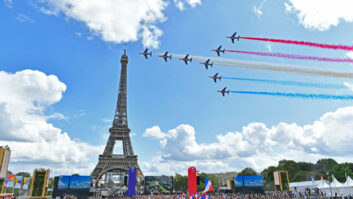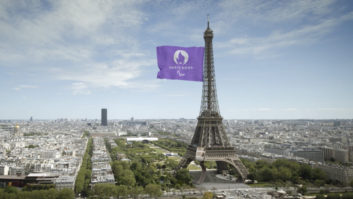A largely-unnoticed pledge made at the time when Britain was merely aspiring to host the Olympics looks set to fuel concerns over bandwidth for wireless cameras attending the event, writes Richard Dean.
According to Guarantee 15.9 of the 2012 XXXth Olympics bid, “The Secretary of State for Trade and Industry has guaranteed on behalf of the UK Government to the waiving of fees payable for the allocated frequencies required for the Games.” Subsequent clarification to the IOC (International Olympic Committee) specified that this included all media, but perversely not revenue-zero emergency, public safety and security services.
The implications of such a generous offer are only now becoming clear. Who will adjudicate requests as being ‘required’ for the Games? Would it for instance include an interview with footballer David Beckham, part of the Olympic bid delegation? Will the manager of the spectrum still be expected to pay Ofcom the normal rent, and if so from which funds? And what incentive will news organisations have not to retain speculative look-out feeds? Many believe that a further call on the public purse is now inevitable, but congestion remains the bigger worry.
Ofcom is desperately looking for ways of meeting an unprecedented demand, not least from the anticipated army of bandwidth-hungry HD wireless cameras. Some years ago wireless camera users were told they would lose the popular 2.6GHz band for PMSE (programme-making and special events) from 1 January 2007 as an auction was imminent, but have since been allowed to continue temporarily under a three-month notice period.
But as Paul Gill, MD of Ofcom frequency management contractor JFMG (Joint Frequency Management Group) points out, the replacement 2.0GHz to 2.2GHz band – which unlike 2.6GHz is not under threat from the deep pockets of mobile operators as interference makes it unsuitable for broadband – has already filled up, even though the old frequency is still in use.
One option is the 7.5GHz band once used for fixed links. “Wimbledon tennis and other major sporting events used to be dominated by trucks with antenna providing fixed links to BT Tower or Crystal Palace for instance,” Gill recalls, “but today most of the venues now have plumbed-in fibre connections. However the demand for mobile camera links at venues or for touchline coverage has exploded, so more frequencies will be needed in the future.” Only a handful of cameras can operate at 7.5GHz, and the same applies to another candidate, 3.5GHz.
A more radical suggestion is for cameras to be allocated Super High Frequency (SHF) bands from 3GHz to 30GHz, or Extremely High Frequency (EHF) at 30GHz to 300GHz. But much of the necessary equipment is still currently at the prototype stage. Broadcasters also point out that these frequencies provide a shorter range and a more tightly-focused beam requiring more skill to align, plus vulnerability to Doppler shift, limiting applications at speed such as onboard motor-racing coverage.
Although some bandwidth will be released as London becomes the last major area to complete digital switchover (DSO) just prior to the 27 July to 9 September Olympic event, much of it will be of little use to wireless cameras. Also, the time-honoured ‘borrowing’ of suitable spectrum for special events could be jeopardised by some frequencies being in private hands by then, making frequencies either too costly or simply unavailable.
Meanwhile Ofcom has yielded to industry pressure by reserving ‘white space’ frequencies between transmitters after DSO for use by PMSE wireless microphones. Initially thought to be at risk from auction, the spectrum will now be awarded to a self-financing ‘band manager’ organisation to be chosen late this year. Having said that, the number was unexpectedly cut from 32 to 30 following late recognition that channels 61 and 62 were auctionable after all. Users will have protected access until 2018.







